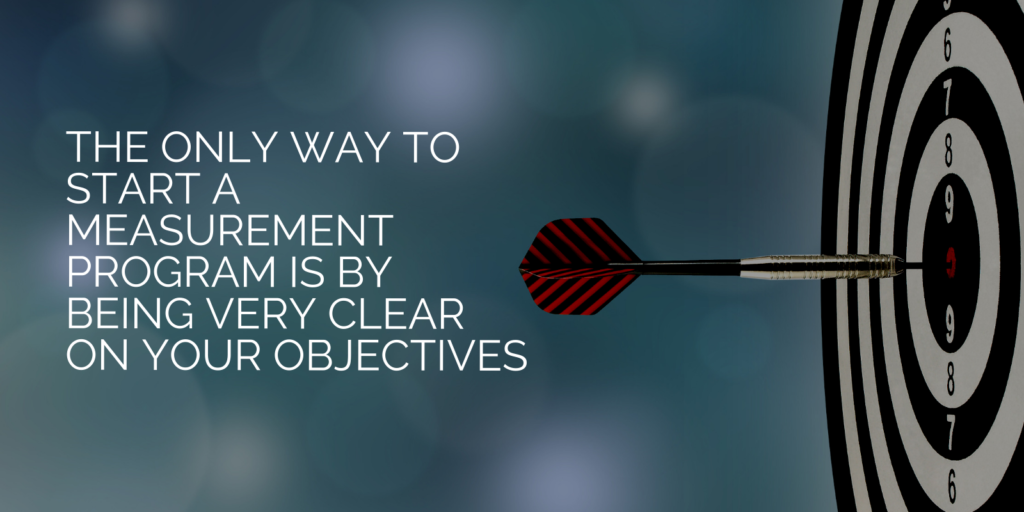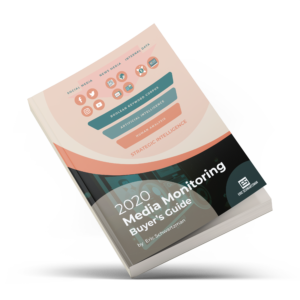
Media monitoring solutions are not one size fits all. There are dozens of providers and even more use cases, so start by figuring out what you want your media monitoring platform to do. Are you looking to track traditional and social or are you looking for strategic insights? When it comes to monitoring, measurement and evaluation, listening for business intelligence is very different to monitoring for mentions, so know your priorities.
Before you start, ask the CEO or the CMO what success looks like. “The only way to start a measurement program is by being very clear on your objectives,” says Katie Paine, CEO of Paine Publishing. “Nine times out of 10 they’ll say your objective is protecting their reputation.”

To do that, at the very least you need to be able to capture and analyze what’s being said about your company, your competitors and the categories in which you compete so you can determine what the widespread beliefs are. It’s tough to interject your point of view into a conversation if you don’t know what people are talking about.
Manually reading traditional and social coverage is generally pretty easy for start-ups, cause there’s not as much being said. But for more established brands, the challenge is digesting and summarizing a large number of articles and online conversations in real time, and then analyzing them with algorithms that don’t understand the meaning of the keywords they’re tracking.
When defining your objectives, understand that if accuracy is mission critical, you’ll need to allocate sufficient resources to review your clips manually to determine widespread beliefs.
AI in Media Monitoring
Many media monitoring services claim they already have artificial intelligence capable of accurately analyzing news articles and social media posts for sentiment. They say their algorithms can automatically evaluate your reputation in real time.
But here’s the thing you need to know. It’s easy to count and score keywords in sentences for sentiment. When you consider the multiple ideas, concepts, topics and sub-topics that can be included in a single news article, accurately interpreting sentiment requires more than just natural language processing. What’s required is natural language understanding.
While AI can help process language in circumstances where the domain is narrow and the goal is concrete, when it comes to multi domain thinking, common-sense reasoning and natural language understanding, AI still falls short and according to most data scientists, it’ll probably be another 40–50 years until machines can process information at that level.
There’s also a very real chance we will never be able to build machines that can reason as well as humans can. According to Kai-Fu Lee, author of AI Superpowers, the risk of replacement for public relations specialists is among the lowest of all professions.
PR won’t be replaced by machines anytime soon. “It also cannot engage in cross domain thinking on creative tasks or ones requiring complex strategy, jobs whose inputs and outcomes aren’t easily quantified,” says Lee.
Get the Steak, Not the Sizzle
Most services have access to the same traditional and social media news feeds, which is square one. Next, you apply Boolean keyword filters to hone in on the right information. At that, there is value to leveraging narrow AI to evaluate sentiment at the entity level, tag articles by concepts and detect geographical origin. And you can try out relevance and sentiment filters as well. But be prepared in step three to check the last two for accuracy.
Strategic insights are at the intersection of media intelligence and external data, which is why the ability to import stuff like call center transcripts and sales figures is so important, so you can spot patterns and figure out how media activity correlates to revenue.
When considering the different media monitoring platforms, rather than focus solely on breadth and depth of content or fancy AI filters, figure out if the platform has the features and capabilities you need to achieve your objectives.
“Do you really need broadcast? Because in my experience, everything winds up online anyway. Do you really need to spend an extra $24k a year, cause that’s how much it could cost. Who’s going to be doing set-up? Do you have a team of data scientists who can write Boolean or are you going to be relying on them to do it? What about reporting? Do you want automated reports or are you going to be doing that yourself? A lot of the automated reports are very pretty, but do they show value?,” asks Jonny Bentwood, Global Head of Data & Analytics at Golin.
Media Monitoring Interview Questions
To help you assess media monitoring platform providers, here’s a list of open ended questions you can use to stimulate exploratory discussions about services:
- Does it get everything or just a snippet?
- Does it get photos and graphics?
- What outlets do we need and does it capture them?
- If it doesn’t, can those outlets be added?
- Does it do social, traditional and broadcast? What about podcasts?
- How many KPIs are available to choose from on your platform?
- How much historical data is accessible?
- Can I bring in third-party data and run comparisons?
- Can I bring in usage data from my social networking profiles?
- Does it have language translation?
- Does it have image recognition so you can search images and video for logos?
- Does it measure KPIs around engagement?
- Does it understand virality, can I set my own virality parameters and how is viral amplification presented/displayed?
- Can I group the media outlets that matter most to me?
- Are there advanced, rules-based alerts you can set up via email and text?
- Instagram is notoriously difficult to monitor. To what extent can they get such data? If they say they can get all of Instagram’s data they’re either scraping it illegally or lying.
- Have you looked at the artificial intelligence layer and evaluated specific articles for relevancy or sentiment scores?
- Do they comply with copyright laws?
- Do they indemnify clients against copyright violations on their part?
The other two things to ask about are onboarding and user support. The biggest cost of changing media monitoring platforms is the time required to train staff so ease of use matters a lot because it saves you money if people can figure out how to use the service themselves.
 But even if the interface is intuitive, you’re still going to need support to leverage the full potential of the platform. Some platforms have dedicated customer success teams devoted to helping you get your service up and running properly so find out what kind of onboarding services and if structured, ongoing training is provided.
But even if the interface is intuitive, you’re still going to need support to leverage the full potential of the platform. Some platforms have dedicated customer success teams devoted to helping you get your service up and running properly so find out what kind of onboarding services and if structured, ongoing training is provided.
For a more comprehensive look at the state of media monitoring technology, download my new 2020 Media Monitoring Buyer’s Guide which includes a side-by-side features comparison grid of all the major providers, a user rating chart with my reviews and analysis.

